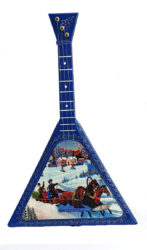Why Balalaika Is The All-Time Popular Instrument In Russia

You might not be familiar with the Balalaika because it is not as famous as other instruments like the piano or violin. This article breaks down what makes this instrument so popular in Russia that it was chosen by composer Modest Mussorgsky to be a part of his masterpiece, “Pictures at an Exhibition.” The Balalaika is a stringed instrument with a short neck and no frets. It was initially a Russian folk instrument that got its name from the word “balalaika,” which means “little violin.” You can see some of these instruments at the Elgin Museum. This is not the same as the Russian Classical Balalaika shown below, known as an “Ustnik” or performer’s instrument.
Where did the word “balalaika” come from? The first recorded use of the word “balalaika” was in 1824, written by Vladimir Biringoff, a Russian writer. He used the word to describe a ballad or folk song that he heard while touring around Southern Russia during the 7th and 8th centuries.
Balalaika History
The Balalaika is a stringed musical instrument popular during the Soviet era. It has a body made out of plywood or pine, and it’s played with a plectrum on the bottom between the bridge and nut. The top wood gives an arched shape when held upright so that the player can play while sitting. The sound of the Balalaika has been described as rich, sweet, and mellow. Its bowing is quick but not too much so that the tension on the string is lost.
Balalaika Types
Balalaika is a traditional Russian instrument made of wood, wire, and horsehair. The name “balalaika” comes from the Russian word for “little bundle,” which was called a balalaika. The Cossacks originally played them in their military encampments. Strictly speaking, a balalaika consists of two pieces of different sizes: the larger one, called the Boukhiya, is held between the player’s knees; and the smaller one, called the kasha, is played in each hand. The Boukhiya is divided into three or four sections, called bars, and the kasha has seven. Each bar is tuned to an individual note so that you can play different notes simultaneously by moving your hands up, down, and across the bars. The Balalaika is a very versatile instrument, and it takes a good deal of practice before one can become proficient in it.
Balalaika Economy
The Balalaika is an instrument that has a long history in Russia. It is also called the strings, which means “big violin” or “big mandolin,” because it is shaped like a violin but with three strings on one side and four strings on the other. It is tuned to two octaves and played with both hands using open strings and metal picks.
Balalaika Instrumentation
The Balalaika is the most popular instrument in Russia. It has been around for 500 years and was initially made out of reeds. It is often used as a folk instrument. There are many different types of Balalaika, but they all sound the same. They are available in all styles, from classical to folk.
There is no one style of Balalaika; however, there are two main types of balalaikas, and they have very distinct timbres. The most commonly found Balalaika is the Russian Tumba (named for St Petersburg). It has a rounded body and a 30-inch neck with a large resonator.
Different Types Of Balalaika Musicians
The Balalaika is a musical instrument from Russia and other parts of Eastern Europe. There are several different types of balalaika musicians, including the mandolin player, accordionist, and fiddler. The most common type of musician is the balalaika player. The instrument is highly portable and can be used in intimate settings. It is a typical folk instrument that does not require a great deal of skill to play.
A very common type of musician who plays the accordion is the accordionist. This type of musician usually plays music at parties and other social gatherings. They play popular melodies that are well known and have particular compositions that they create themselves.
Conclusion
The Balalaika, a three-stringed Russian mandolin, has been around since the 16th century. In many ways, it’s similar to the guitar. However, there are some significant differences between these instruments. The Balalaika is often used in Russian folk music and is one of the few instruments to be played without picking up your hands on the strings.
You can get the awesome Balalaika from The Russian Treasures website. Explore our web store to know more about Russian tradition and culture.
